I’ve been thinking a lot about space lately. I watched a lot of the World Cup, US Open and Chesapeake Invite and found a lot between the wide-angle filming of the World Cup and NexGen’s work. Both show huge chunks of field and all (or at least most) of the players involved in the action. Game film shot in this way, from up high and holding all of the action in the frame, is incredibly useful for looking at space. And while there isn’t a single way to organize space, most successful teams work to create useful space on the field; here is some of what I’ve noticed.
Brute Squad
Boston isn’t an all-the-time vertical stack team, often employing a modified horizontal set. However, here we see them in a classic 80s vertical stack (no dump). Every method of managing space has areas of the field that are open and areas that are closed. This set provides two primary open areas: the obvious lane down the strongside where Seville is looking to Witte-Garcia for the big gainer and the swing space to Baecher off the front of the stack. Moving the reset to the front of the stack makes for a more difficult throw, but creates the space for a more advantageous one, provided you can complete it. Unlike a side stack, a vertical also creates a secondary space on the far side of the field that can be reached after a swing pass. The deep space is moderately open to a powerful thrower. Brute’s stack is very clean. This has the advantage of clearly defining the open spaces and the disadvantage of completely closing the center of the field.
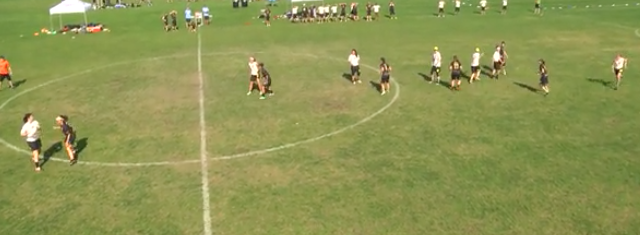
Ironside
In contrast to the clarity of the vertical stack pictured above, the Boston men play primarily out of a muddy vertical. In this picture, there are only four players in the stack: Garcia is clearing down the far sideline and the dump is just out of the frame to the left. From this central position, Marquette has access to the strongside lane (which is occupied by Garcia), the weakside lane and the dump space. This close to the end zone, the deep space is pretty small and not much of a concern for the defenders in the back of the stack.
The advantage of a muddy stack is more options to the center of the field. If the handler at the front of the stack cuts, the two central cutters in the stack are immediately options; it’s as if the offense has instantly morphed into a horizontal. The disadvantage is that the spaces aren’t as clearly defined. Malachek is at the back of the stack and has his defender turned, but Stubbs is partly out in the lane blocking Malachek’s access. In a cleaner stack, Stubbs wouldn’t be open at all, but Malachek would have a free run into the big part of the field.
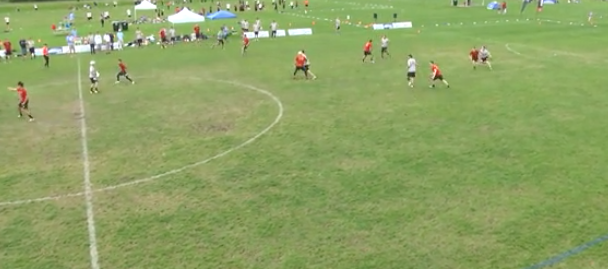
Chain
Yet another team using a vertical stack, Atlanta’s take is to crowd all six cutting players onto the strongside. Jay Clark is the furtherest horizontal player from the disc and he is barely across midfield. There is a lot of jamming it up the strongside in this offense; ideally Spiva’s deep cut (red hat) should have sprung Wilson’s under cut. Unluckily, Inselmann has turned away to the dump at just the wrong moment.
Because the cutters are positioned so close to the active lane, no lateral set up is necessary and the cutting in this offense is very in-out. There is also an ocean of space on the weakside of the field (just look at it!!) that is accessible off of any kind of swing pass. The obvious disadvantage is how tight and crowded things are around the disc.
Fury
Lauren Casey holds the disc in the center of the field and looks to Alex Snyder isolated in front of the disc. This is classic Fury – a clean, deliberate horizontal stack. Fury’s goal is to spread out the defense and create a pocket of space 10-15 yards in front of the disc for their famous ‘7’ cut. The positioning of the other downfield cutters achieves two purposes: first, they are in the right place to run continuation cuts for Snyder. They are also directly connected to the thrower – should their defenders poach, they are immediately open.
This offense puts immense pressure on the downfield defenders, but the downside is that it puts very, very little pressure on the handler defenders. Both Fajardo and Narayan’s defenders have sagged out into the lanes, crowding the space Snyder is trying to utilize.
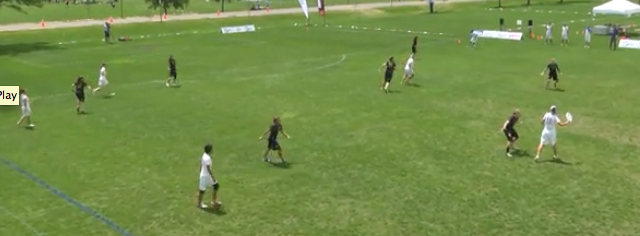
Revolver
Unlike the other teams mentioned so far, Revolver doesn’t operate out of a set shape, instead relying on general principles to create space and opportunity. (Yes, they are famous for their sidestack, but it is typically used as a specialized set for pull plays.) In this capture, Cahill has just received the disc in the center of the field and four of the six cutting players are at or behind the line of scrimmage. With only Rasmussen and Sanchez downfield, there is little either defender can do (particularly since they are both wrong-sided) and an easy backhand goal to Rasmussen immediately follows.
This moment illustrates an essential concept of Revolver’s offense – create space by clearing wide and shallow. This forces defenders to choose to either complete bail on their player and help or leave their fellow defenders in isolation. Neither is a great option, which is why this is good offense.
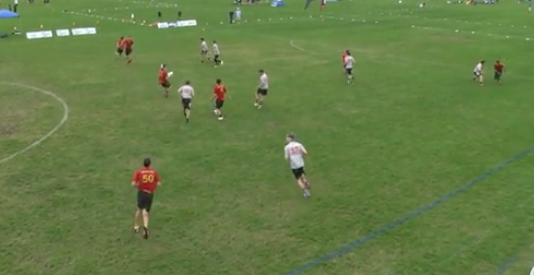
Machine
Ostensibly a vertical stack team, Machine is much closer to Revolver than the other vert teams discussed here. Where they differ from Revolver is that instead of active clearing to create space, Machine relies on active and constant cutting to open up the field. Cluster stack might be a better term than vertical – when you look at this offense at any frozen moment, there isn’t any discernible structure. The goal here is to create little angles and openings that trigger a series of little passes followed by a big: dink-dink-dink huck.
Nelson has just received the disc complete surrounded by offensive players and the disc is immediately dished Sheehan then Vandervoort and then Kelly is wide open running out. This type of offense relies on creative and intuitive reads – nothing here is clearly defined. When it works, it is beautiful; when it doesn’t it’s a mess.
Scandal
DC is running a neo-traditional endzone offense – clean vertical stack in the endzone with three handlers operating outside. The handlers run give-and-goes to the open side, setting up the swing pass counter. Here it is Jenny Fey going up the line; she is slightly open, but nowhere near as open as Alicia White. Johnston recognizes and is in the process of hitting the swing. The goal immediately follows on the weakside.
This offense isn’t unique to Scandal; it is probably the most common endzone offense in high level club and college ultimate. I’ve included it to introduce a concept called ‘wake cutting’. The essential idea is that motion creates space and particularly creates space behind the cutter, in her ‘wake’. White was not open until Fey’s upline cut drew all involved three defenders – it was in Fey’s wake that the opening was created. For another example, go back to the Chain photo; Wilson’s cut is in Spiva’s wake.
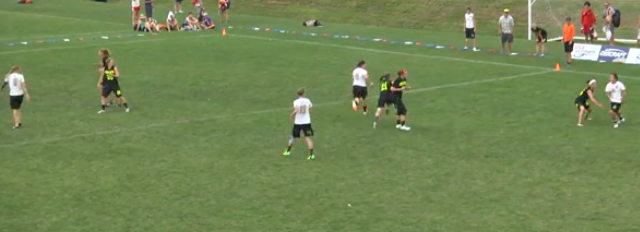
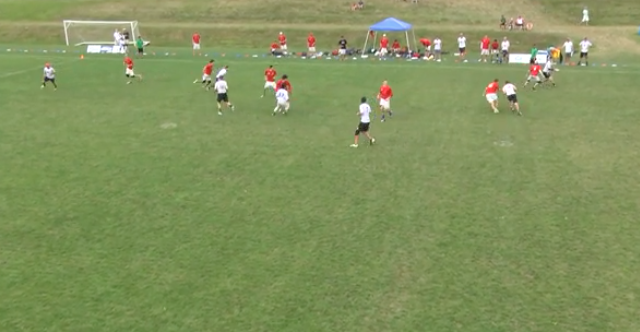
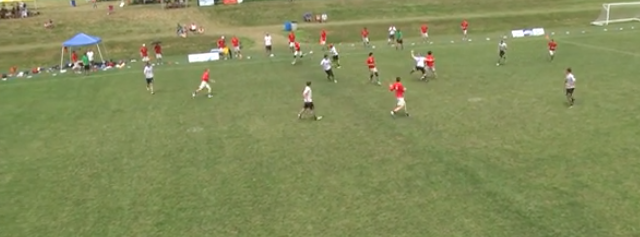







Comments Policy: At Skyd, we value all legitimate contributions to the discussion of ultimate. However, please ensure your input is respectful. Hateful, slanderous, or disrespectful comments will be deleted. For grammatical, factual, and typographic errors, instead of leaving a comment, please e-mail our editors directly at editors [at] skydmagazine.com.